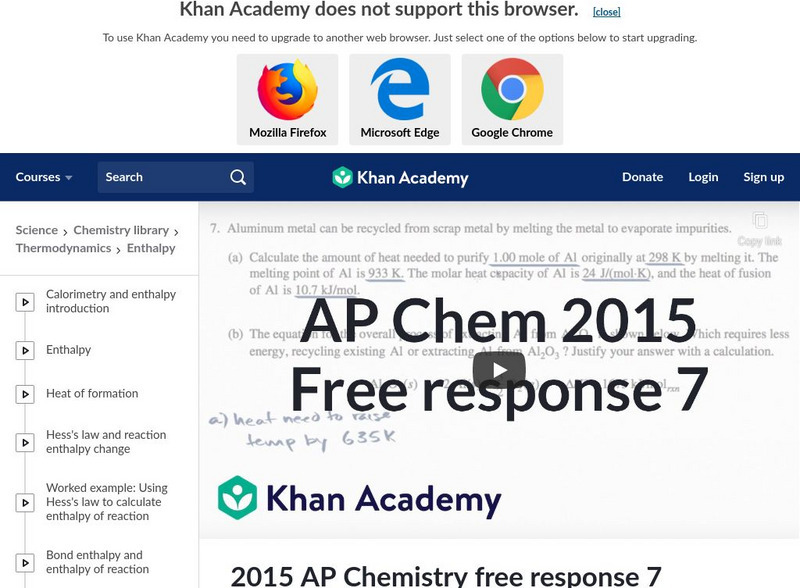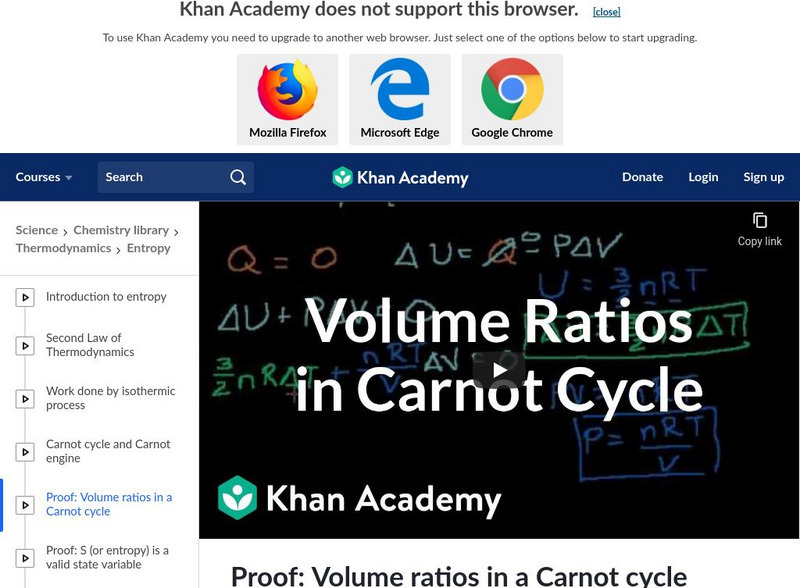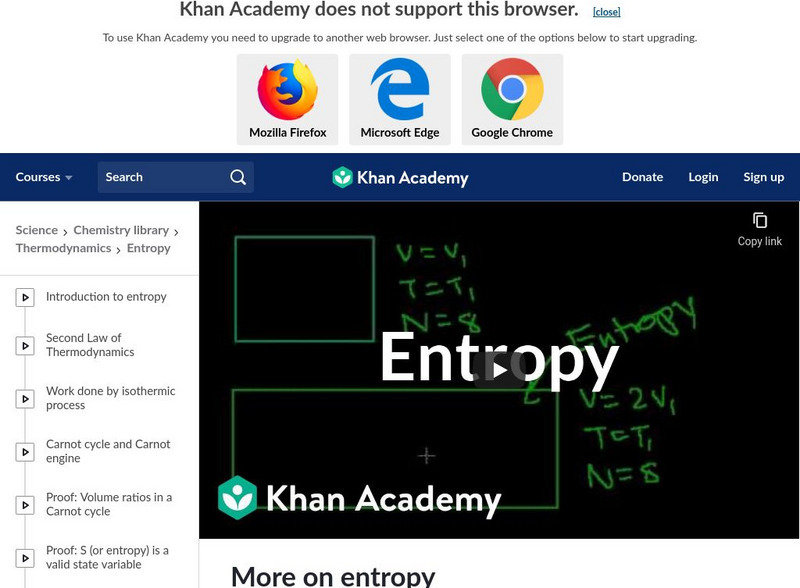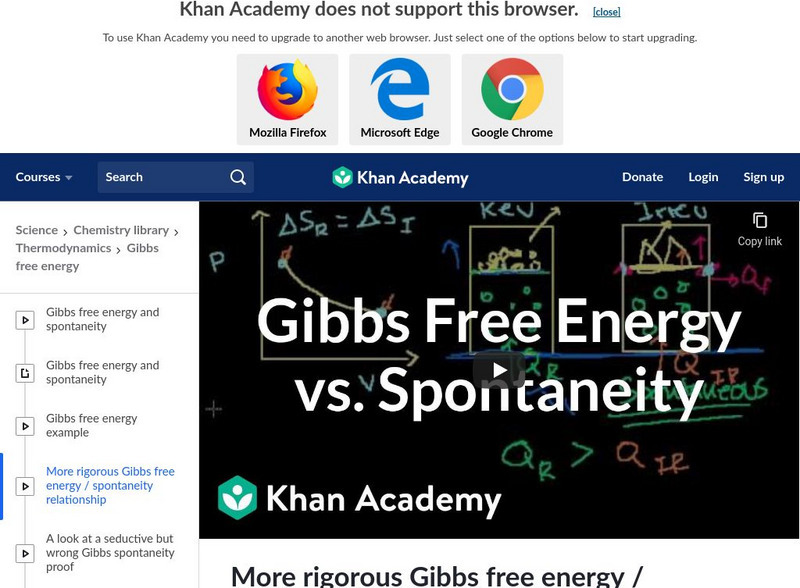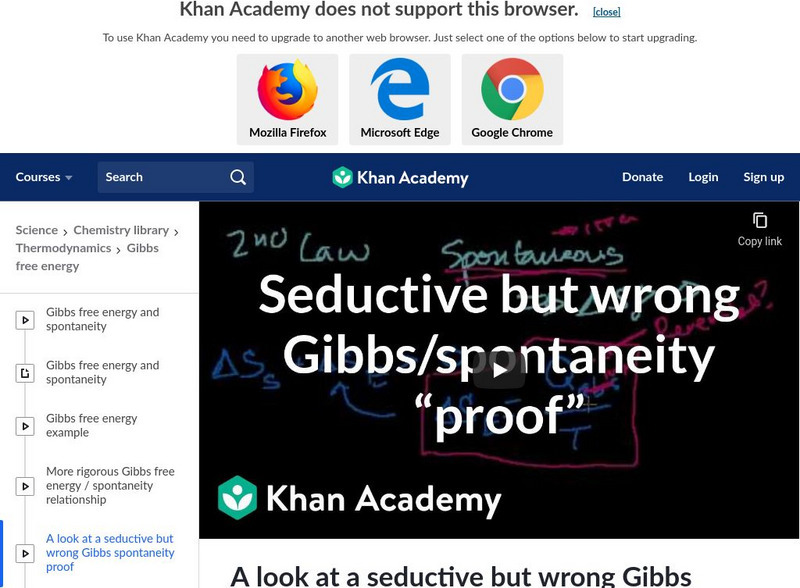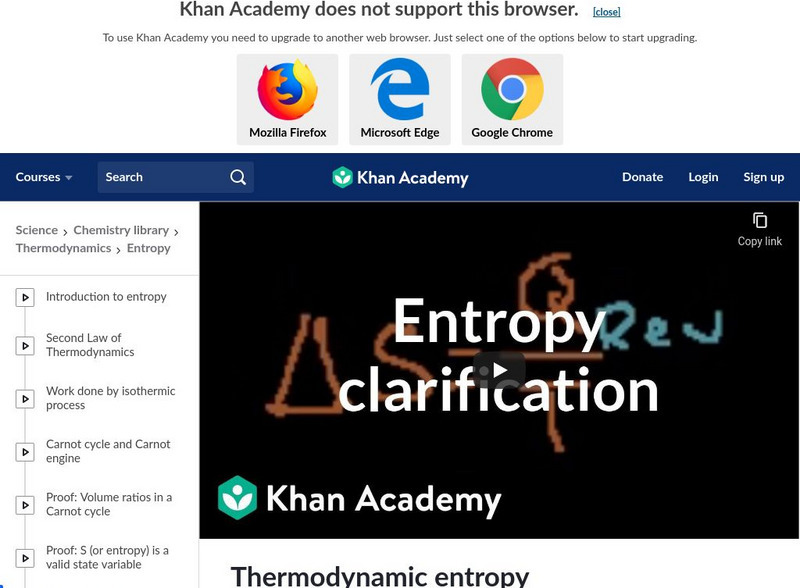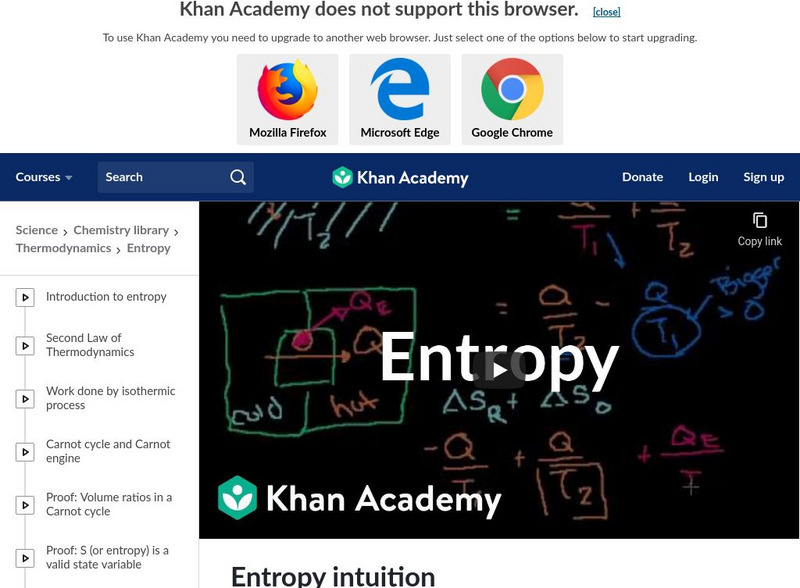Khan Academy
Khan Academy: 2015 Ap Chemistry Free Response 7
Calculating the necessary energy to recycle aluminum from aluminum oxide which was a question on the 2015 AP Chemistry exam. [6:16]
Khan Academy
Khan Academy: Carnot Cycle and Carnot Engine
An introductory explanation of the Carnot Cycle and the Carnot Heat Engine. [20:52]
Khan Academy
Khan Academy: Proof: Volume Ratios in a Carnot Cycle
An explanation to prove the volume ratios in a Carnot cycle. [17:08]
Khan Academy
Khan Academy: Proof: S (Or Entropy) Is a Valid State Variable
An explanation to prove that entropy, labeled as S, is a valid state variable. [15:38]
Khan Academy
Khan Academy: More on Entropy
An explanation showing the differences between microstates and macrostates emphasizing that entropy is defined for a system and not different microstates. [8:56]
Khan Academy
Khan Academy: Maxwell's Demon
Explanation of a concept that seems to defy the Second Law of Thermodynamics. [13:27]
Khan Academy
Khan Academy: More Rigorous Gibbs Free Energy / Spontaneity Relationship
Extended explanation of the effect of a negative charge on Gibbs Free Energy. [13:56]
Khan Academy
Khan Academy: A Look Ar a Seductive but Wrong Gibbs/spontaneity Proof
An explanation why many textbooks are incorrect in their details about the "proof" of the relation between Gibbs free energy state and spontaneity. [6:41]
Khan Academy
Khan Academy: Changes in Free Energy and the Reaction Quotient
An explanation of Gibbs Free Energy and the reaction quotient under conditions that are not standard. [15:47]
Khan Academy
Khan Academy: Thermodynamic Entropy Definition Clarification
Using a reversible system to clarify the definition of entropy in thermodynamics. [15:38]
Khan Academy
Khan Academy: Entropy Intuition
An introduction to the Second Law of Thermodynamics focusing on terms of heat and microstates. [19:15]
Bozeman Science
Bozeman Science: Total Energy
In the following video Paul Andersen explains how the total energy of a system is the combination of kinetic, potential and internal energy of the objects. He then shows you how to calculate the kinetic energy, gravitational potential...
Crash Course
Crash Course Physics #23: Thermodynamics
Have you ever heard of a Perpetual Motion Machine? More to the point, have you ever heard of why Perpetual Motion Machines are impossible? One of the reasons is because of the first law of thermodynamics! In this video [10:04] episode of...
Khan Academy
Khan Academy: Chemistry: Carnot Cycle and Carnot Engine
A video lecture discussing the four processes of the Carnot cycle. Each step of the process is described and illustrated relating the temperature change and whether heat was absorbed or released. Also explained is the P-V diagram for the...
Khan Academy
Khan Academy: Chemistry: More on Internal Energy
A video lecture that explores internal energy and how to calculate how much heat is transferred to or from the system. Lecture gives examples to help your understanding of the concepts. [13:45]
Khan Academy
Khan Academy: Chemistry: Work From Expansion
A video lecture showing how heat is transferred between systems, how to calculate work, and how if the system is doing work the volume increases. Lecture uses diagrams and examples to help illustrate concepts. [12:43]
Khan Academy
Khan Academy: Chemistry
A video lecture that builds on previous knowledge of enthalpy to find out how much heat energy is either gained or lost in a reaction. By being able to predict how much heat it takes to produce certain products, it is explained to...
Khan Academy
Khan Academy: Chemistry: Proof: U=(3/2)pv or U=(3/2)n Rt
A video lecture that relates pressure, volume, and temperature to internal energy. The lecture shows how to derive an equation for the ideal gas to relate internal energy and pressure and volume. The video shows that if the temperautre...
Bozeman Science
Bozeman Science: Internal Energy
In the following video Paul Andersen explains how the internal energy of a system can change as the internal structure of the system changes. An object model will not be able to account for the restoring forces and so a system model must...
Learn Engineering
Learn Engineering: Working of Steam Turbine
Learn how steam turbine engines create mechanical energy by transforming thermal energy. Follow the path of energy transformation as high energy fluid travels through rotor blades. Also understand the three energy components of flowing...
Khan Academy
Khan Academy: Chemistry: First Law of Thermodynamics/internal Energy
A video lecture defining the first law of thermodynamics and internal energy. Understand that energy is only transferred from one form to another and not created or destroyed. Also learn how measure the amount of energy something has as...
Khan Academy
Khan Academy: Chilling Water Problem
How much ice at -10 degrees C is necessary to get 500 g of water down to 0 degrees C? [11:23]
Khan Academy
Khan Academy: Proof: U = (3/2)Pv or U = (3/2)N Rt
Conceptual proof that the internal energy of an ideal gas system is 3/2 PV. [16:55]
Khan Academy
Khan Academy: First Law of Thermodynamics / Internal Energy
First law of thermodynamic and internal energy. [17:40]
